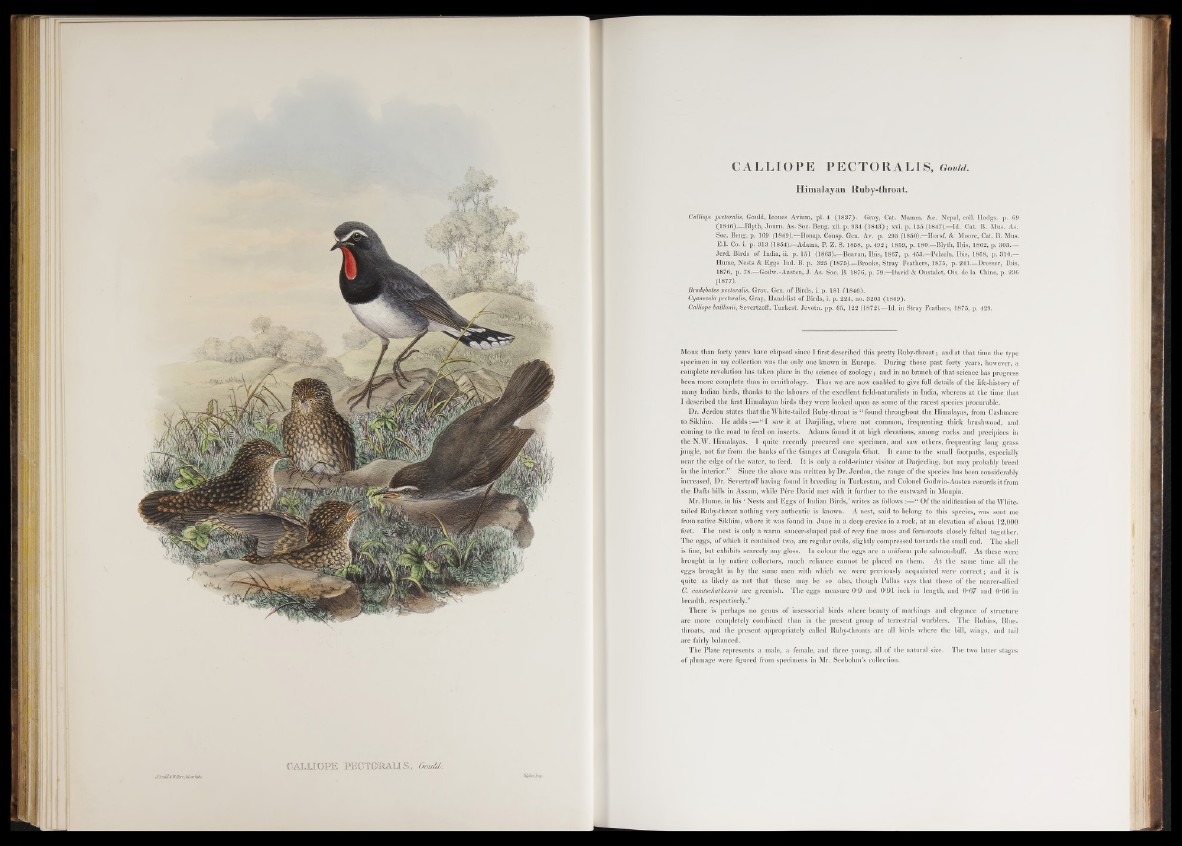
CALLIOPE BECTQBAUS, X m
CALLIOPE PECTORALIS, Gould.
Himalayan Ruby-throat.
Calliope pectoralis, Gould, leones Avium, pi. 4 (1837). Gray, Cat. Mamm. &c. Nepal, coll. Hodgs. p. 69
(1846).—Blyth, Journ. As. Soe. Beng. xii. p. 934 (1843); xvi. p. 135 (1847).—Id. Cat. B. Mus. As.
Soc. Beng. p. 169 (1849).—Bonap. Consp. Gen. Av. p. 295 (1850).—Horsf. & Moore, Cat. B. Mus.
E.I. Co. i. p. 313 (1854).—Adams, P. Z. S. 1858, p. 492; 1859, p. 180.—Blyth, Ibis, 1862, p. 803.—
Jerd. Birds of India, ii. p. 151 (1863).—Beavan, Ibis, 1867, p. 453.—Pelzeln, Ibis, 1868, p. 310,—|
Hume, Nests & Eggs Ind. B. p. 325 (1875).—Brooks, Stray Feathers, 1875, p. 241.—Dresser, Ibis,
1876, p. 78.—Godw.-Austen, J. As. Soc. B, 1876, p. 79.—David & Oustalet, Ois. de la Chine, p. 236
(1877).
Bradybates pectoralis, Gray, Gen. of Birds, i. p. 181 (1846).
Cyanecula pectoralis, Gray, Hand-list of Birds, i. p. 224, no. 3203 (1869).
Calliope baillonii, Severtzoff, Turkest. Jevotn. pp. 65, 122 (1872).—Id. in Stray Feathers, 1875, p. 429.
M o r e than forty years have elapsed since I first described this pretty Ruby-throat; and at that time the type
specimen in my collection was the only one known in Europe. During those past forty years, however, a
complete revolution has taken place in the science o f zoology; and in no branch o f that science has progress
been more complete than in ornithology. Thus we are now enabled to give full details of the life-history of
many Indian birds, thanks to the labours o f the excellent field-naturalists in India, whereas a t the time that
I described the first Himalayan birds they were looked upon as some of the rarest species procurable.
Dr. Jerdon states that the White-tailed Ruby-throat is “ found throughout the Himalayas, from Cashmere
to Sikhim. He adds :—“ I saw it a t Darjiling, where not common, frequenting thick brushwood, and
coming to the road to feed on insects. Adams found it a t high elevations, among rocks and precipices in
the N.W. Himalayas. I quite recently procured one specimen, and saw others, frequenting long grass
jungle, not far from the banks o f the Ganges a t Caragola Ghat. I t came to the small footpaths, especially
near the edge of the water, to feed. It is only a cold-winter visitor at Darjeeling, but may probably breed
in the interior.” Since the above was written by Dr. Jerdon, the range of the species has been considerably
increased, Dr. Severtzoff having found it breeding in Turkestan, and Colonel Godwin-Austen records it from
the Dafla hills in Assam, while Pere David met with it further to the eastward in Moupin.
Mr. Hume, in his ‘ Nests and Eggs of Indian Birds,’ writes as follows:—“ O f the nidification o f the Whitetailed
Ruby-throat nothing very authentic is known. A nest, said to belong to this species, was sent me
from native Sikhim, where it was found in June in a deep crevice in a rock, at an elevation o f about 12,000
feet. The nest is only a warm saucer-shaped pad o f very fine moss and fern-roots closely felted together.
The eggs, of which it contained two, are regular ovals, slightly compressed towards the small end. The shell
is fine, but exhibits scarcely any gloss. In colour the eggs are a uniform pale salmon-buff. As these were
brought in by native collectors, much reliance cannot be placed on them. At the same time all the
eggs brought in by the same men with which we were previously acquainted were c o rre c t; and it is
quite as likely as not that these may be so also, though Pallas says that those o f the nearer-allied
C. camtschatkemis are greenish. The eggs measure 0 '9 and 0*91 inch in length, and 0 -67 and 0 ‘66 in
breadth, respectively.”
There is perhaps no genus of insessorial birds where beauty of markings and elegance of structure
are more completely combined than in the present group of terrestrial warblers. The Robins, Blue-
throats, and the present appropriately called Ruby-throats are all birds where the bill, wings, and tail
are fairly balanced.
The Plate represents a male, a female, and three young, all of the natural size. The two latter stages
of plumage were figured from specimens in Mr. Seebohm’s collection.